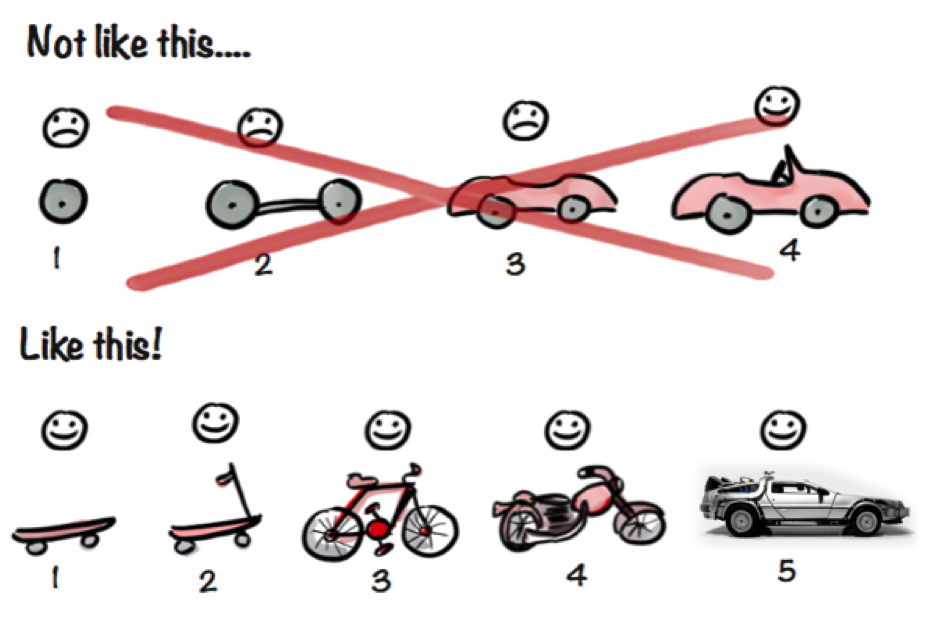This year, 2015, is the year where Marty McFly traveled into the future and found flying cars, hovering skate boards and self-tying shoes. Now here we are in that brave new world, with all three of those futuristic products well beyond the prototype phase (see here, here and here.)
But what if Marty had taken his time-traveling DeLorean and explored what learning might have looked like in 2015? What if Doc, instead of coming up with the flux capacitor, had an epiphany with fresh innovations for learning?
In honor of this year’s “Back to the Future” milestone, I’ve been delivering a presentation titled, “Back to the Future of Learning,” where I (and hat tip to my co-presenter, Laura Bowen) share several trends in the world of training and development – everything from social learning to flipped classrooms to robots and artificial intelligence.
In fact, none of these learning trends are that futuristic! They have arrived already in 2015. Ways of learning we never could have imagined in 1955 or 1985 are here today and here to stay. I highlight five of them below:
1. Micro Learning
Q: What can you really learn in 2-3 minutes? A: More than you think! In a world where six second videos hang out on Vine and human attention spans are worse than goldfish, people aren’t giving you much time to teach them anything. Lest you despair at our fleeting focus, I want to give you hope. Based on stats from our online learning community, GovLoop Academy, we know that visitors will watch a video for roughly four minutes if we offer them compelling content. This two-minute clip is a great example:
I’m pretty amazed at how much content our learning designers were able to pack into 120 seconds with three different perspectives and interesting visuals that reinforce what’s being said. Even better news: we’ve found that you can leverage micro-learning for more technical topics like corridor management and cyber security. I’d be happy to show examples – hit me up at [email protected].
2. Flipped Classroom
What if you arrived at a live training session prepared to contribute to the conversation? That’s the premise behind a flipped classroom approach to learning. Rather than listening to someone else drone on from the front of the room, what if you watched a series of short videos like the one I just showed above before coming to class? With that cursory information, you could spend more time in a live session working with the instructor and your colleagues to grapple with case studies or apply those concepts to your unique situation. In a previous post, my colleague talked about how GovLoop deployed this flipped classroom approach with the Federal Highway Administration and saw great results. The video below walks through an overview of how we flipped the classroom for that FHWA course titled “Performance Management Approach to Operations:”
Notice that we asked learners to watch a couple videos, complete a knowledge check to ensure that they got the main points, then invited them to participate in an hour-long, live online session. We’d call it a webinar, but it wasn’t like the webinars you’ve likely experienced. Instead of being talked at for an hour, they engaged in a direct conversation with the subject matter experts from the videos as well as their peers. An unexpected benefit was that more seasoned colleagues were able to share their in-the-trenches experience with folks who were newer to the field. Last note: please don’t just record the lecture and make them watch it ahead of time – get rid of the boring lecture all together!
3. Minimally Viable Courses
 Most training design efforts take several months. You have to research the subject matter, create an instructional design document, build out all the content (live lessons, reading, exercises), assemble it all in a coherent set of resources (instructor and participant guides, slides, etc.), then unveil it to participants, hoping it hits the mark for their learning needs. At the speed with which information changes these days, that’s not a sustainable model for crafting meaningful and timely learning experiences. That’s why we’ve been taking an agile approach to developing online courses. The top line of the graphic to the right presents the old, more linear way of thinking about development. The bottom illustrates how you can create just enough learning content that allows you to present valuable information while also gaining feedback from participants in real time.
Most training design efforts take several months. You have to research the subject matter, create an instructional design document, build out all the content (live lessons, reading, exercises), assemble it all in a coherent set of resources (instructor and participant guides, slides, etc.), then unveil it to participants, hoping it hits the mark for their learning needs. At the speed with which information changes these days, that’s not a sustainable model for crafting meaningful and timely learning experiences. That’s why we’ve been taking an agile approach to developing online courses. The top line of the graphic to the right presents the old, more linear way of thinking about development. The bottom illustrates how you can create just enough learning content that allows you to present valuable information while also gaining feedback from participants in real time.
For instance, GovLoop recently developed a seven-week, social learning course for an agency with a general design sketch in mind, but released only one week of content at a time to participants. We then conducted real-time evaluations with them each week (both knowledge checks and satisfaction surveys) to determine effectiveness, then adjusted the learning experience in subsequent weeks based on participant input.
Another way this could work is to create an overview course, then ask participants what would be most relevant to explore in greater depth. As an example, we created this video for aspiring leaders that covers three topics: managing self, managing others and managing for organizational impact (hat tip to Brian Crewe, former Chief Learning Officer at the Department of Transportation, who is featured in the clip):
One way we’d use this video with an agency is to ask participants which of the three themes resonated most with them. With that quick input, we’d build a series of other short videos based on interviews with senior leaders and experienced managers who are known to have demonstrated competency in that skill area. We would structure the course around the learners’ needs rather than having them sit through everything in an order that we pre-determined without ever having listened to them. We’d also save money by building it bit by bit vs. biting off the whole course at once. To weave in the “Back to the Future” theme, we like to say, “You don’t have to build a DeLorean if a skateboard gets you going!”
4. Mobile and Wearable Learning
This one might seem pretty obvious – you can watch those videos on your phone or tablet! Yes, that’s true. But what I find most promising about the use of mobile, wearable technology are two things: (1) the ability to prompt a person to take an action based on something they learned, and (2) the ability for that person to record whether or not they’ve taken that action. This reality is already happening with our phones when we get reminders from an app or sign up to receive a text message about something that’s important to us (the weather, a flight, etc.).
 But let me give you a more concrete example that’s applied to learning. Say, for instance, that I am a new manager and just completed a course for new supervisors, whether online or in person. As a concluding exercise, let’s say that I sign up to receive a series of random prompts by text message that ask me a simple question around the content of the course, such as:
But let me give you a more concrete example that’s applied to learning. Say, for instance, that I am a new manager and just completed a course for new supervisors, whether online or in person. As a concluding exercise, let’s say that I sign up to receive a series of random prompts by text message that ask me a simple question around the content of the course, such as:
- Have you walked around your office today to check in with your employees?
- Have you expressed sincere appreciation for a task or action completed by a member of your team today?
- Have you proactively addressed an area where an employee requires constructive feedback?
With one simple message delivered at unknown points in a new manager’s workday, you are accomplishing two things: you are reinforcing the principles of the training session AND you are inviting them to give a simple response that allows you to collect data about their performance. Let’s say they have not performed that action yet and seek to “game” the system by doing it, then responding when it’s done. Would we really be opposed to that scenario? They are still, ultimately, engaging in the behavior that was one of the desired outcomes from the training!
Quick side note: we are building a similar functionality into GovLoop Academy through the Action Plans feature. Right now, a user can record what they’d like to learn and what they’ve completed…but we’re already thinking toward the future where they watch a video, then can opt in to reminders that encourage them to apply what they’ve learned on the job.
5. Artificial Intelligence + Robot-Assisted Learning
So while I’m throwing this last one in just for fun, I do think there are some interesting applications for the use of robots in training. The example I like to cite is tied to improvement in public speaking or better briefing techniques. Imagine being able to practice delivering a speech in front of a robot that is recording you. When you finish your presentation, it provides a report on the number of verbal tics (umm, ahh, errr), your pace and cadence (i.e. number of words per minutes and length of pauses between thoughts), as well as the emotions conveyed by your facial expressions and body language (do you appear angry? nervous? giddy?). Perhaps the same robot is programmed to have a series of short videos that you can watch in real-time based on the report you just received. Then you practice again and again until you’re a well-oiled, speaking, uh, machine.
And just in case you think that’s a bit too weird, I wanted to spring something really spooky on you just to show that my idea (a) isn’t too far-fetched and (b) is a lot less awkward than this situation:
So those are five trends I’m tracking in 2015.
I’m pretty sure Doc would be pleased at all this innovation. And remember:






Loved this article, lots of great trends and amazing how fast everything is happening. From the workforce/development angle, it’s nice to see a lot of focus on the shorter programs designed to give people the skills needed to get back into the workforce, hopefully finding employment easily and earning a higher wage. So it’s great seeing curriculum/content being developed in partnership with employers, so prospective employees can quickly gain the skills they need and get to work. Robots kind of scare me! But yes, will play an increasingly important role in learning, and our entire economy….
Pat! Thanks for the thoughts. Robots are about to take over, my friend. It’s only a matter of time.
I love GOVLoop. It feeds new information…not at all boring and the content leads me to new developments in the government.